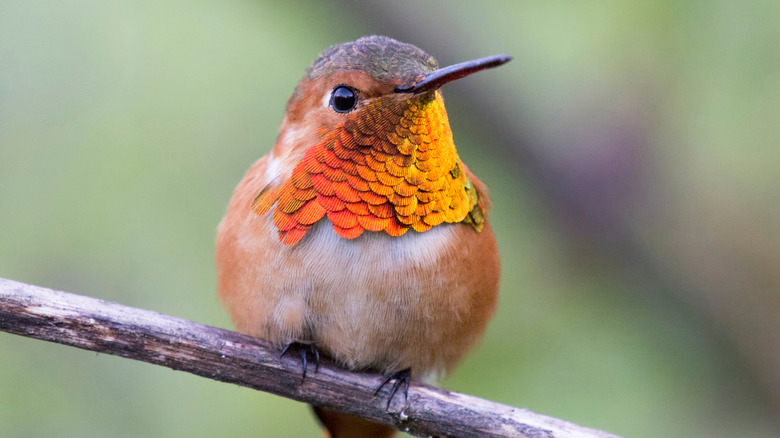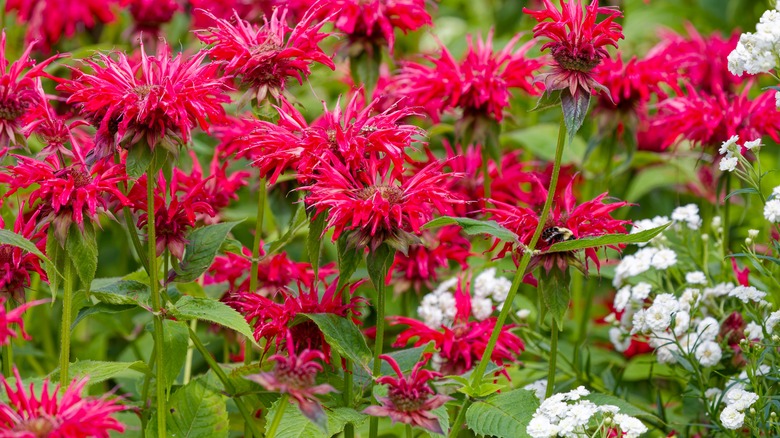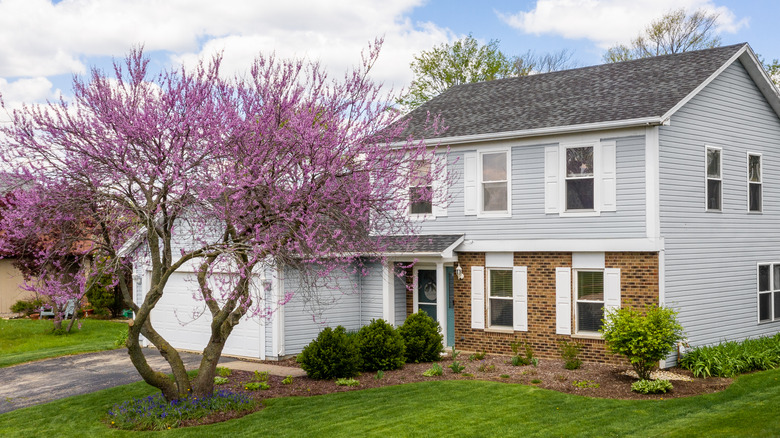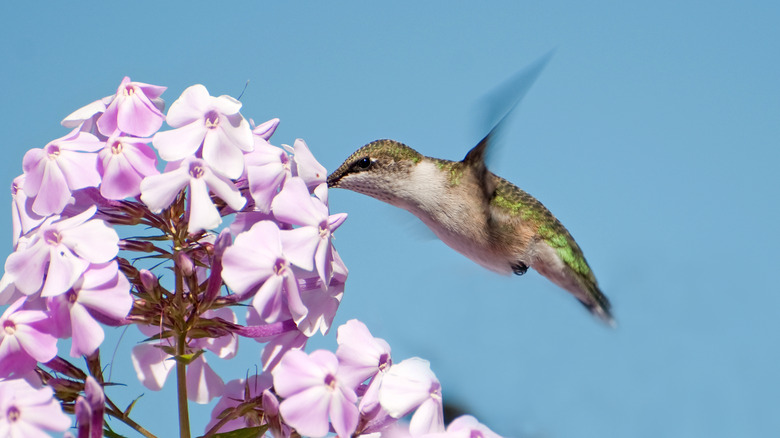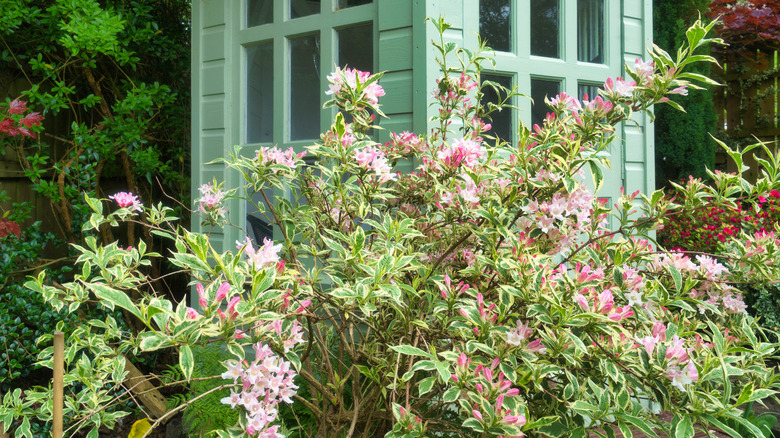Trees And Bushes To Plant In November To Attract Beautiful Hummingbirds
We may receive a commission on purchases made from links.
Who would have guessed it, but apparently, hummingbirds like a tropical vacation as much as many humans do. As the weather gets colder across the United States and Canada, the tiny flutterers begin packing it up and heading to the sunshine and floral joys of Central America and Mexico. But just because the hummingbirds have headed south, it's no reason to abandon thoughts of them flitting about your garden, happily slurping sweet nectar and pollinating everything they touch. In fact, November is an ideal time to start preparing to lure the speedy-winged hummers back to your yard when the weather warms up again. You can do so by planting the trees and bushes most likely to attract beautiful hummingbirds.
There are numerous options for small and large foliage that can be planted even into late autumn. Bushes such as the hummer-rific Bonnie Plants Bee Balm and trees like the eastern redbud are adaptable enough to be planted as you're raking leaves and doing other autumn tasks. In the Northern hemisphere, November days are optimum planting days for trees and shrubs. Cloud cover is common during the month in many parts of the United States, which may keep freezing temperatures at bay for a little longer, and helps minimize stress to the plants. Getting the plants off to a good start lets them grow robust roots so that come spring they're ready to burst with flowers to charm the returning hummingbirds. The most difficult decision is which ones to plant, like red buckeye, tall garden phlox, and weigela.
Beautiful beebalm is a pollinator favorite
Beebalm (Monarda fistulosa), which you might sometimes see written as "bee balm" or referred to as wild bergamot, is a member of the mint family, but unlike some other mints, it isn't invasive. It isn't hard to successfully grow beebalm plants since they're pretty easy-going. It's even one of the flowering perennials that's easy to grow from seeds if you don't have a green thumb in USDA hardiness zones 3 through 9.
Most varieties of the pretty perennial grow about 2 to 4 feet tall, and they're fairly tolerant of most types of soils and varying growing conditions. They do like to bask in ample sunshine, however, so that they can grow plenty of flowers for the hummingbirds to visit. A little shade is okay, but for the most part, wild bergamot or beebalm isn't wild about spots that are too shady. Of bigger concern is the amount of moisture and air circulation the plant gets. It doesn't mind some wetness, but areas prone to flooding or consistent dampness aren't a good location for beebalm. Likewise, it prefers to have space. If it's too crowded, mildew can be an issue.
Eastern redbud looks gorgeous in any landscape
The hummingbird isn't the only one enamored with the eastern redbud (Cercis canadensis). Founding Father, Thomas Jefferson, planted the trees in multiple places at Monticello, his estate in Virginia. Perhaps he liked that the early blooms of the eastern redbud are a welcome sight for people coming out of the winter months. Before the heart-shaped leaves have unfurled, the eastern redbud's flowers are waking up sleepy suburban neighborhoods and trendy urban streets with a cheerful, "Rise and shine!"
The eastern redbud is fast out of the gate in other ways, too, since it gets off to a quick start in life in zones 4 through 9 before mellowing out to a more moderate growth rate after a few years. In addition to attracting brightly-colored hummingbirds, the eastern redbud tree is a showoff for all seasons. In the dead of winter, homeowners and passers-by can enjoy the quirky-looking bark that appears to peel away from the trunk as though it got a really bad sunburn over the summer.
Red buckeye offers many benefits
The red buckeye (Aesculus pavia) is a medium-sized tree that reaches a max height of 20 feet. This understory tree grows in zones 4 through 8 with blooms appearing early in the spring, making it very appealing to hungry hummingbirds. They are especially fond of the brilliant dark red to magenta tubular flowers that cover the trees abundantly. It's no wonder it made the list of 8 flowering trees that'll attract hummingbirds to your yard and garden.
Pretty as it is, however, there are two cautionary notes. First, you'll want to check with your state's cooperative extension office before purchasing and planting one. The red buckeye and the yellow buckeye (Aesculus flava Ait.) are native in some areas, but also appear on the invasive species list in some regions. Secondly, even if you can grow one in your area, you'll want to be cognizant of its danger if you have small children who live with you or visit often. The tree's seeds are toxic, as are new shoots, according to the Lady Bird Johnson Wildflower Center.
Tall garden phlox is a beautiful as it is nectar-rich
This hummingbird favorite is a showstopper! Sometimes as tall as an adult, tall garden phlox (Phlox paniculata) is an impressive flower. It blooms mostly in shades of lavender, purple, pink, rose, red, and white, just like its little cousin, creeping phlox (Phlox subulata). The big difference is tall garden phlox reaches skyward to make it easier for those busy hummingbirds to drink the nectar in all their flowers. And the zippy avians will be lining up for a long sip when they return from their winter digs.
Tall garden phlox can be planted into the cooler months of fall, but don't wait too long. While it can tolerate being planted in autumn, it prefers spring planting. If you're planting in November, choose a warm day about four weeks before the first expected frost in warmer areas of zones 2 through 9. Be sure the planting site is well-drained and add compost if necessary to ensure it is rich in nutrients. A location that gets about six hours of sunshine, possibly with a little afternoon shade (more if you're in a hotter climate), is best. If you find you don't have time to plant tall garden phlox in November, plan on getting some in the ground in the spring, and maybe even buy an extra couple so you can try the unconventional way to plant garden phlox to attract more hummingbirds. (Hint: It's inside a hanging basket!)
Weigela forms gorgeous arches full of flowers
The deciduous shrub with pretty little flowers that are usually some shade of pink but can vary from off-white or cream to burgundy is sometimes called "old-fashioned" weigela or Korean weigela (Weigela florida). Many gardeners know it as a reliable bush that will show off its beautifully-arched, flower-laden branches like a burlesque chorus girl sporting a new boa. How weigela arrived in Western gardens almost 200 years ago, though, is not nearly so old-fashioned, nor as vaudevillian. It's a little more along the lines of science meets theft meets "Mission Impossible!"
Robert Fortune, a botanist from Scotland, traveled several times to China following the Opium Wars in the middle of the 19th century. He was searching for new plants to bring back, and he was quite successful, amassing 20,000 plants which were reportedly "smuggled" out of China. Among the living souvenirs were tea plants, which ended China's tea monopoly, and weigela, which now graces gardens around the world. The elegant branches of weigela can intertwine and form a thick hedge if you let it. So, depending on how you feel about your neighbors, weigela could be a dense privacy shrub full of tubular flowers that are perfect for hummingbirds, too. Some varieties are smaller, but Weigela florida can grow as big as 10 feet tall and 12 feet wide. It might be a good landscaping option in case you're planning a heist of some far away flora of your own, for the sake of the hummingbirds, of course.
